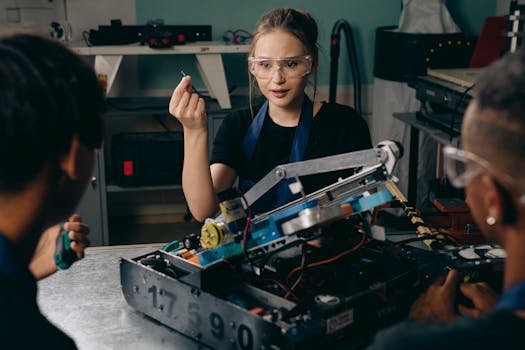Unveiling the IES Labyrinth: A Parent's Guide to Spanish Secondary Education
The demanding yet richly rewarding world of the Instituto de Enseñanza Secundaria (IES) system requires astute navigation. Let's dissect key facets, offering insights gleaned from years of experience within the system.
1. Charting the Academic Course: 'Bachillerato' or 'Formación Profesional'? The pivotal decision confronting parents and students is selecting the appropriate post-primary pathway. 'Bachillerato', a rigorous academic program, lays the groundwork for university entrance, branching into diverse specializations – sciences, humanities, and others. Conversely, 'Formación Profesional' (FP), a vocational track, equips students with practical skills, potentially leading to immediate employment or further specialized training. Dismissing a child's initial leanings is short-sighted; instead, actively seek counsel from educational advisors and utilize aptitude assessments. Consider it akin to selecting a career trajectory – some lead to prestigious executive suites; others to fulfilling entrepreneurial ventures. The ideal path hinges entirely on the student's inherent abilities and aspirations.
2. Deciphering the Numerical Enigma: Beyond the Grade While the Spanish grading scale, ranging from zero to ten, with five signifying competence, provides a numerical summary, it's merely a superficial indicator. Teacher annotations, often overlooked, furnish invaluable insights into your child's strengths and weaknesses, far exceeding the mere score's limitations. Think of it as receiving a comprehensive diagnostic report, rather than just a final prognosis. This detailed analysis illuminates your child's educational journey, guiding your support efforts. Maintain consistent dialogue with educators, regardless of the numerical grade; proactive communication is essential.
3. Cultivating a Supportive Ecosystem: The Social Dynamics The IES ecosystem presents a complex social tapestry. Foster the development of robust peer relationships and mentoring connections. Early detection of potential difficulties, like peer harassment or social isolation, is paramount in preventing significant setbacks. Imagine it as tending a vibrant garden; prompt attention to burgeoning problems prevents them from overshadowing your child's well-being.
4. Enriching the Educational Tapestry: Extracurricular Pursuits Frequently underestimated, extracurricular engagement is fundamental to holistic development. Participation in athletics, clubs, or community service instills crucial life skills, promotes social integration, and can significantly enhance university applications. Consider it comparable to adding essential nutrients to the soil, fostering resilience and robust growth beyond mere academic achievements.
5. Leveraging Available Resources: A Wealth of Support A comprehensive network of support exists for students and parents. IES-based educational counselors provide expert guidance. Furthermore, local libraries, online platforms, and private tutoring services represent indispensable resources for students requiring additional assistance. Don't hesitate to utilize these invaluable aids; they are designed to foster success.
6. The Cornerstone of Success: Open Communication Transparent and consistent communication among parents, students, and teachers forms the bedrock of effective support. This facilitates early problem recognition and proactive intervention. Establish a secure and welcoming home environment where your child feels comfortable discussing their academic and social experiences.
Guiding Your Child Through the Pivotal Years of the IES: A Parent's Essential Guide
As a seasoned educator and parent deeply familiar with the Spanish educational system, I know firsthand how profoundly the Instituto de Educación Secundaria (IES) years shape a child's destiny. These formative years aren't merely about academics; they forge the very essence of who they become. Understanding the IES is paramount for unlocking your child's inherent potential and ensuring their journey is both successful and fulfilling.
1. Parental Partnership: The Wind in Their Sails: Your active involvement is not simply helpful; it's indispensable. Think of it as providing the crucial tailwind that propels your child towards their academic and personal aspirations. This powerful home-school alliance fosters a vibrant learning environment, nurturing their engagement and determination throughout this demanding but rewarding phase.
2. A Foundation for Lifelong Success: The Cornerstone of their Future: The IES curriculum forms the robust bedrock upon which your child will construct their future. Whether their ambitions lie in the hallowed halls of university or the practical mastery of a skilled trade, a thorough grasp of their academic progress is fundamental. A strong IES foundation ensures they're firmly on the path towards achieving their goals, leaving them well-equipped to tackle life's challenges. For further insights into post-secondary options, consider reading Post-Secondary Education: Is It Still Worth the Price Tag? A Cost-Benefit Analysis for the Modern Age (Please replace with a valid URL).
3. Forging Character: The Crucible of Social and Emotional Development: The IES is a complex tapestry woven with threads of social interaction and emotional growth. It's a demanding environment, much like a blacksmith meticulously shaping metal, where resilience is honed, communication flourishes, and social acuity blossoms. The resulting product – a well-adjusted, confident, and capable young adult – is undeniably worth the investment of time and effort.
4. Preparing for the Voyage of Adulthood: Equipping Them for Independence: The IES subtly, yet powerfully, instills the crucial life skills necessary for navigating the complexities of independent adulthood. Time management becomes second nature; responsibility takes root; self-advocacy sharpens their voice. This is akin to provisioning a ship for a long ocean voyage, ensuring it has the navigational tools and sustenance required for a successful and safe journey to its destination. For educators considering alternative career paths, Escape the Classroom, Not Your Passion: Unlocking High-Impact Consulting Careers for Educators (Please replace with a valid URL) offers valuable insights.
5. Early Intervention: Preventing Cracks Before They Become Chasms: Prompt identification of any academic or social hurdles allows for timely and effective intervention. Addressing smaller challenges early prevents them from escalating into significant obstacles, acting as a preventative measure – akin to repairing a hairline fracture in a building's foundation before it compromises the entire structure. For strategies on thriving in the classroom, see The Educator's Anti-Handbook: Rebellious Strategies for Thriving in the Classroom (Please replace with a valid URL).
In conclusion, by actively engaging with the IES system and providing your insightful support, you become a guiding force in your child's life, empowering them to not just survive but thrive during this critical juncture.






